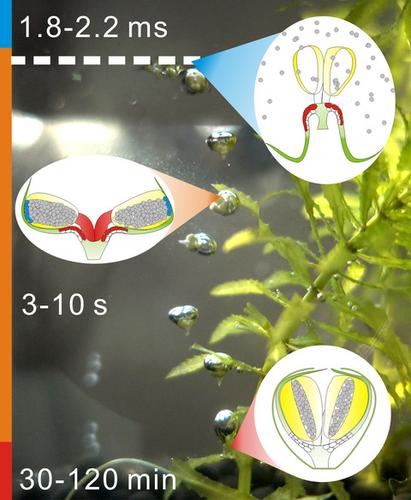当前位置:
X-MOL 学术
›
Plant Biol.
›
论文详情
Our official English website, www.x-mol.net, welcomes your
feedback! (Note: you will need to create a separate account there.)
Ingenious floral structure drives explosive pollination in Hydrilla verticillata (Hydrocharitaceae).
Plant Biology ( IF 4.2 ) Pub Date : 2020-01-08 , DOI: 10.1111/plb.13085 Q Zhang 1 , W-L Fu 2, 3 , X-F Wang 1 , L-J Huang 4
Plant Biology ( IF 4.2 ) Pub Date : 2020-01-08 , DOI: 10.1111/plb.13085 Q Zhang 1 , W-L Fu 2, 3 , X-F Wang 1 , L-J Huang 4
Affiliation

|
In explosive pollination, many structures and mechanisms have evolved to achieve high-speed stamen movement. The male flower of the submerged plant Hydrilla verticillata is reported to be able to release pollen explosively some time after leaving the mother plant time, but the mechanism of stamen movement and the related functional structure in this species are unclear. In this study, we observed the male flower structure and pollen dispersal process of H. verticillata. We analysed the stamen movements during the pollen dispersal process and conducted several controlled experiments to study the process of storage and release of elastic potential energy in explosive pollination. When the male flower of H. verticillata is bound to the united bracts, the sepals accumulate elastic potential energy through the expansion of basal extensor cells. After the male flower is liberated from the mother plant, the stamens unfold rapidly with the sepals under adhesion and transfer the elastic potential energy to the filament in seconds. Once stamens unfold to a critical angle, at which the elasticity of the filament just exceeds the adhesion between sepals and anthers, the stamens automatically rebound and release pollen in milliseconds. These results reveal that Catapult-like stamens, spoon-shaped sepals and enclosed united bracts in the spathe together constitute the functional structure in rapid stamen movement of H. verticillata. They ensure that the pollen can be released on the water surface, and thus adapt successfully to the pollen-epihydrophilous pollination.
中文翻译:

独特的花艺结构推动了Hydrilla verticillata(Hydrocharitaceae)的爆炸性授粉。
在爆炸性授粉中,已经发展出许多结构和机制来实现高速雄蕊运动。据报道,淹没的植物Hydrilla verticillata的雄花在离开母株后的一段时间内能够爆炸性释放花粉,但该物种的雄蕊运动机制和相关功能结构尚不清楚。在这项研究中,我们观察到了H. verticillata的雄性花结构和花粉散布过程。我们分析了花粉散布过程中的雄蕊运动,并进行了一些受控实验,以研究爆炸性授粉中弹性势能的存储和释放过程。当H. verticillata的雄花与统一的act片结合时,萼片通过基底伸肌细胞的膨胀积累弹性势能。从雄性植物中释放出雄花后,雄蕊在与萼片的粘附下迅速展开,并在几秒钟内将弹性势能转移到花丝上。一旦雄蕊展开到临界角,在该临界角处,花丝的弹性刚好超过萼片和花药之间的附着力,雄蕊会在几毫秒内自动反弹并释放花粉。这些结果表明,茎秆中的弹射状雄蕊,匙状萼片和封闭的unit片共同构成了黄褐斑病快速雄蕊运动的功能结构。它们确保花粉可以在水表面释放,从而成功地适应花粉表亲疏水性授粉。雄蕊在粘连的萼片下迅速展开,并在几秒钟内将弹性势能转移到细丝上。一旦雄蕊展开到临界角,在该临界角处,花丝的弹性刚好超过萼片和花药之间的附着力,雄蕊会在几毫秒内自动反弹并释放花粉。这些结果表明,茎秆中的弹射状雄蕊,匙状萼片和封闭的unit片共同构成了黄褐藻快速雄蕊运动的功能结构。它们确保花粉可以在水表面释放,从而成功地适应花粉表亲疏水性授粉。雄蕊在粘连的萼片下迅速展开,并在几秒钟内将弹性势能转移到细丝上。一旦雄蕊展开到临界角,在该临界角处,花丝的弹性刚好超过萼片和花药之间的附着力,雄蕊会在几毫秒内自动反弹并释放花粉。这些结果表明,茎秆中的弹射状雄蕊,匙状萼片和封闭的unit片共同构成了黄褐藻快速雄蕊运动的功能结构。它们确保花粉可以在水表面释放,从而成功地适应花粉表亲疏水性授粉。雄蕊会自动反弹并在几毫秒内释放出花粉。这些结果表明,茎秆中的弹射状雄蕊,匙状萼片和封闭的unit片共同构成了黄褐藻快速雄蕊运动的功能结构。它们确保花粉可以在水表面释放,从而成功地适应花粉表亲疏水性授粉。雄蕊会自动反弹并在几毫秒内释放出花粉。这些结果表明,茎秆中的弹射状雄蕊,匙状萼片和封闭的unit片共同构成了黄褐藻快速雄蕊运动的功能结构。它们确保花粉可以在水表面释放,从而成功地适应花粉表亲疏水性授粉。
更新日期:2020-01-08
中文翻译:

独特的花艺结构推动了Hydrilla verticillata(Hydrocharitaceae)的爆炸性授粉。
在爆炸性授粉中,已经发展出许多结构和机制来实现高速雄蕊运动。据报道,淹没的植物Hydrilla verticillata的雄花在离开母株后的一段时间内能够爆炸性释放花粉,但该物种的雄蕊运动机制和相关功能结构尚不清楚。在这项研究中,我们观察到了H. verticillata的雄性花结构和花粉散布过程。我们分析了花粉散布过程中的雄蕊运动,并进行了一些受控实验,以研究爆炸性授粉中弹性势能的存储和释放过程。当H. verticillata的雄花与统一的act片结合时,萼片通过基底伸肌细胞的膨胀积累弹性势能。从雄性植物中释放出雄花后,雄蕊在与萼片的粘附下迅速展开,并在几秒钟内将弹性势能转移到花丝上。一旦雄蕊展开到临界角,在该临界角处,花丝的弹性刚好超过萼片和花药之间的附着力,雄蕊会在几毫秒内自动反弹并释放花粉。这些结果表明,茎秆中的弹射状雄蕊,匙状萼片和封闭的unit片共同构成了黄褐斑病快速雄蕊运动的功能结构。它们确保花粉可以在水表面释放,从而成功地适应花粉表亲疏水性授粉。雄蕊在粘连的萼片下迅速展开,并在几秒钟内将弹性势能转移到细丝上。一旦雄蕊展开到临界角,在该临界角处,花丝的弹性刚好超过萼片和花药之间的附着力,雄蕊会在几毫秒内自动反弹并释放花粉。这些结果表明,茎秆中的弹射状雄蕊,匙状萼片和封闭的unit片共同构成了黄褐藻快速雄蕊运动的功能结构。它们确保花粉可以在水表面释放,从而成功地适应花粉表亲疏水性授粉。雄蕊在粘连的萼片下迅速展开,并在几秒钟内将弹性势能转移到细丝上。一旦雄蕊展开到临界角,在该临界角处,花丝的弹性刚好超过萼片和花药之间的附着力,雄蕊会在几毫秒内自动反弹并释放花粉。这些结果表明,茎秆中的弹射状雄蕊,匙状萼片和封闭的unit片共同构成了黄褐藻快速雄蕊运动的功能结构。它们确保花粉可以在水表面释放,从而成功地适应花粉表亲疏水性授粉。雄蕊会自动反弹并在几毫秒内释放出花粉。这些结果表明,茎秆中的弹射状雄蕊,匙状萼片和封闭的unit片共同构成了黄褐藻快速雄蕊运动的功能结构。它们确保花粉可以在水表面释放,从而成功地适应花粉表亲疏水性授粉。雄蕊会自动反弹并在几毫秒内释放出花粉。这些结果表明,茎秆中的弹射状雄蕊,匙状萼片和封闭的unit片共同构成了黄褐藻快速雄蕊运动的功能结构。它们确保花粉可以在水表面释放,从而成功地适应花粉表亲疏水性授粉。





















































 京公网安备 11010802027423号
京公网安备 11010802027423号